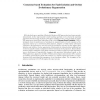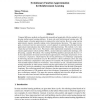26 search results - page 2 / 6 » Evaluation of Different Fitness Functions for the Evolutiona... |
ICES
2005
Springer
13 years 10 months ago
2005
Springer
While the fault repair capability of Evolvable Hardware (EH) approaches have been previously demonstrated, further improvements to fault handling capability can be achieved by exp...
ITSSA
2006
13 years 5 months ago
2006
: An autonomic network must work unsupervised, therefore must be able to respond to unpredictable situations. The BIONETS project is working towards resilient network services that...
GECCO
2010
Springer
13 years 5 months ago
2010
Springer
This paper takes an economic approach to derive an evolutionary learning model based entirely on the endogenous employment of genetic operators in the service of self-interested a...
ASC
2011
13 years 9 days ago
2011
A new paradigm for online EH regeneration using Genetic Algorithms (GAs) called Competitive Runtime Reconfiguration (CRR) is developed where performance is assessed based upon a b...
CORR
2010
Springer
13 years 5 months ago
2010
Springer
Temporal difference methods are theoretically grounded and empirically effective methods for addressing reinforcement learning problems. In most real-world reinforcement learning ...


